The Impact of Background-Level Carboxylated Single-Walled Carbon Nanotubes (SWCNTs−COOH) on Induced Toxicity in Caenorhabditis elegans and Human Cells
Abstract
:1. Introduction
2. Materials and Methods
2.1. Reagents
2.2. Characterization of SWCNTs−COOH
2.3. C. elegans Maintenance, Acute Exposure Treatment, Lifespan, and Lethality Assays of C. elegans
2.4. Growth Measurement of C. elegans
2.5. Locomotion Assay of C. elegans
2.6. Reproductive Assay of C. elegans
2.7. Intracellular ROS Staining
2.8. Intracellular ROS Localization Assays of C. elegans
2.9. Cell Viability and ROS Generation Assays of THP-1 Cells
2.10. Quantitative Real-Time PCR (qRT-PCR) Assays
2.11. Statistical Analysis
3. Results and Discussion
3.1. Characterization of SWCNTs−COOH
3.2. Part I: Caenorhabditis elegans (C. elegans) Animal Model Experiment
3.2.1. Lethal Effects of SWCNTs−COOH
3.2.2. Observed Reduced Lifespan of C. elegans after Exposure of the Nematodes to SWCNTs−COOH
3.2.3. Observed Reduced Growth of C. elegans after the Exposure of Nematodes to SWCNTs−COOH
3.2.4. Adverse Effect of SWCNTs−COOH on the Reproduction of C. elegans
3.2.5. Effects of SWCNTs−COOH on the Locomotion Behavior of C. elegans
3.2.6. Effects of SWCNTs−COOH on the Intracellular ROS Generation and Localization of Nematodes
3.2.7. Upregulation of Antioxidant Gene Expression in SWCNTs−COOH-Treated Nematodes
3.3. Part II: THP-1 Cells In Vitro Model Experiment
3.3.1. Effects of SWCNTs−COOH on Cell Viability and ROS Generation in THP-1 Cells
3.3.2. Alteration of Antioxidant Gene Expression in THP-1 Cells following Treatment with SWCNTs−COOH
4. Conclusions
Author Contributions
Funding
Institutional Review Board Statement
Informed Consent Statement
Data Availability Statement
Acknowledgments
Conflicts of Interest
References
- Valsami-Jones, E.; Lynch, I. NANOSAFETY. How safe are nanomaterials? Science 2015, 350, 388–389. [Google Scholar] [CrossRef] [PubMed]
- Baughman, R.H.; Zakhidov, A.A.; de Heer, W.A. Carbon nanotubes—The route toward applications. Science 2002, 297, 787–792. [Google Scholar] [CrossRef] [PubMed] [Green Version]
- Kruss, S.; Hilmer, A.J.; Zhang, J.Q.; Reuel, N.F.; Mu, B.; Strano, M.S. Carbon nanotubes as optical biomedical sensors. Adv. Drug Deliver. Rev. 2013, 65, 1933–1950. [Google Scholar] [CrossRef] [PubMed]
- Vardharajula, S.; Ali, S.Z.; Tiwari, P.M.; Eroglu, E.; Vig, K.; Dennis, V.A.; Singh, S.R. Functionalized carbon nanotubes: Biomedical applications. Int. J. Nanomed. 2012, 7, 5361–5374. [Google Scholar]
- Iijima, S.; Ichihashi, T. Single-Shell Carbon Nanotubes of 1-Nm Diameter. Nature 1993, 363, 603–605. [Google Scholar] [CrossRef]
- Hedman, D.; Barzegar, H.R.; Rosen, A.; Wagberg, T.; Larsson, J.A. On the Stability and Abundance of Single Walled Carbon Nanotubes. Sci. Rep.-UK 2015, 5, 16850. [Google Scholar] [CrossRef]
- Cui, J.M.; Yang, D.H.; Zeng, X.; Zhou, N.G.; Liu, H.P. Recent progress on the structure separation of single-wall carbon nanotubes. Nanotechnology 2017, 28, 452001. [Google Scholar] [CrossRef] [Green Version]
- Kymakis, E.; Alexandou, I.; Amaratunga, G.A.J. Single-walled carbon nanotube-polymer composites: Electrical, optical and structural investigation. Synth. Met. 2002, 127, 59–62. [Google Scholar] [CrossRef]
- Liang, F.; Chen, B. A Review on Biomedical Applications of Single-Walled Carbon Nanotubes. Curr. Med. Chem. 2010, 17, 10–24. [Google Scholar] [CrossRef]
- Hassellov, M.; Readman, J.W.; Ranville, J.F.; Tiede, K. Nanoparticle analysis and characterization methodologies in environmental risk assessment of engineered nanoparticles. Ecotoxicology 2008, 17, 344–361. [Google Scholar] [CrossRef]
- Lam, C.W.; James, J.T.; McCluskey, R.; Hunter, R.L. Pulmonary toxicity of single-wall carbon nanotubes in mice 7 and 90 days after intratracheal instillation. Toxicol. Sci. 2004, 77, 126–134. [Google Scholar] [CrossRef] [PubMed] [Green Version]
- Doudrick, K.; Herckes, P.; Westerhoff, P. Detection of Carbon Nanotubes in Environmental Matrices Using Programmed Thermal Analysis. Environ. Sci. Technol. 2012, 46, 12246–12253. [Google Scholar] [CrossRef] [PubMed]
- Petersen, E.J.; Flores-Cervantes, D.X.; Bucheli, T.D.; Elliott, L.C.; Fagan, J.A.; Gogos, A.; Hanna, S.; Kagi, R.; Mansfield, E.; Bustos, A.R.; et al. Quantification of Carbon Nanotubes in Environmental Matrices: Current Capabilities, Case Studies, and Future Prospects. Environ. Sci. Technol. 2016, 50, 4587–4605. [Google Scholar] [CrossRef] [PubMed]
- Murray, A.R.; Kisin, E.; Leonard, S.S.; Young, S.H.; Kommineni, C.; Kagan, V.E.; Castranova, V.; Shvedova, A.A. Oxidative stress and inflammatory response in dermal toxicity of single-walled carbon nanotubes. Toxicology 2009, 257, 161–171. [Google Scholar] [CrossRef] [PubMed]
- Umeda, Y.; Kasai, T.; Saito, M.; Kondo, H.; Toya, T.; Aiso, S.; Okuda, H.; Nishizawa, T.; Fukushima, S. Two-week Toxicity of Multi-walled Carbon Nanotubes by Whole-body Inhalation Exposure in Rats. J. Toxicol. Pathol. 2013, 26, 131–140. [Google Scholar] [CrossRef] [PubMed] [Green Version]
- Campagnolo, L.; Massimiani, M.; Palmieri, G.; Bernardini, R.; Sacchetti, C.; Bergamaschi, A.; Vecchione, L.; Magrini, A.; Bottini, M.; Pietroiusti, A. Biodistribution and toxicity of pegylated single wall carbon nanotubes in pregnant mice. Part. Fibre Toxicol. 2013, 10, 21. [Google Scholar] [CrossRef] [Green Version]
- Maynard, A.D.; Warheit, D.B.; Philbert, M.A. The new toxicology of sophisticated materials: Nanotoxicology and beyond. Toxicol. Sci. 2011, 120 (Suppl. S1), S109–S129. [Google Scholar] [CrossRef]
- Khaliullin, T.O.; Fatkhutdinova, L.M.; Zalyalov, R.R.; Kisin, E.R.; Murray, A.R.; Shvedova, A.A. In vitro toxic effects of different types of carbon nanotubes. Mater. Sci. Eng. B-Adv. 2015, 98, 012021. [Google Scholar] [CrossRef]
- Dong, P.X.; Wan, B.; Guo, L.H. In vitro toxicity of acid-functionalized single-walled carbon nanotubes: Effects on murine macrophages and gene expression profiling. Nanotoxicology 2012, 6, 288–303. [Google Scholar] [CrossRef]
- Sun, Y.P.; Fu, K.F.; Lin, Y.; Huang, W.J. Functionalized carbon nanotubes: Properties and applications. Acc. Chem. Res. 2002, 35, 1096–1104. [Google Scholar] [CrossRef]
- Hou, W.C.; He, C.J.; Wang, Y.S.; Wang, D.K.; Zepp, R.G. Phototransformation-Induced Aggregation of Functionalized Single-Walled Carbon Nanotubes: The Importance of Amorphous Carbon. Environ. Sci. Technol. 2016, 50, 3494–3502. [Google Scholar] [CrossRef] [PubMed]
- Arndt, D.A.; Moua, M.; Chen, J.; Klaper, R.D. Core Structure and Surface Functionalization of Carbon Nanomaterials Alter Impacts to Daphnid Mortality, Reproduction, and Growth: Acute Assays Do Not Predict Chronic Exposure Impacts. Environ. Sci. Technol. 2013, 47, 9444–9452. [Google Scholar] [CrossRef] [PubMed]
- Wang, R.; Mikoryak, C.; Li, S.; Bushdiecker, D., 2nd; Musselman, I.H.; Pantano, P.; Draper, R.K. Cytotoxicity screening of single-walled carbon nanotubes: Detection and removal of cytotoxic contaminants from carboxylated carbon nanotubes. Mol. Pharm. 2011, 8, 1351–1361. [Google Scholar] [CrossRef] [Green Version]
- Liu, D.; Yi, C.; Zhang, D.; Zhang, J.; Yang, M. Inhibition of proliferation and differentiation of mesenchymal stem cells by carboxylated carbon nanotubes. ACS Nano 2010, 4, 2185–2195. [Google Scholar] [CrossRef]
- Fujita, K.; Fukuda, M.; Endoh, S.; Kato, H.; Maru, J.; Nakamura, A.; Uchino, K.; Shinohara, N.; Obara, S.; Nagano, R.; et al. Physical properties of single-wall carbon nanotubes in cell culture and their dispersal due to alveolar epithelial cell response. Toxicol. Mech. Method 2013, 23, 598–609. [Google Scholar] [CrossRef]
- Mrakovcic, M.; Meindl, C.; Leitinger, G.; Roblegg, E.; Frohlich, E. Carboxylated short single-walled carbon nanotubes but not plain and multi-walled short carbon nanotubes show in vitro genotoxicity. Toxicol. Sci. 2015, 144, 114–127. [Google Scholar] [CrossRef] [PubMed] [Green Version]
- Mu, Q.; Du, G.; Chen, T.; Zhang, B.; Yan, B. Suppression of human bone morphogenetic protein signaling by carboxylated single-walled carbon nanotubes. Acs Nano 2009, 3, 1139–1144. [Google Scholar] [CrossRef]
- Fujita, K.; Fukuda, M.; Fukui, H.; Horie, M.; Endoh, S.; Uchida, K.; Shichiri, M.; Morimoto, Y.; Ogami, A.; Iwahashi, H. Intratracheal instillation of single-wall carbon nanotubes in the rat lung induces time-dependent changes in gene expression. Nanotoxicology 2015, 9, 290–301. [Google Scholar] [CrossRef] [Green Version]
- Warheit, D.B.; Laurence, B.R.; Reed, K.L.; Roach, D.H.; Reynolds, G.A.; Webb, T.R. Comparative pulmonary toxicity assessment of single-wall carbon nanotubes in rats. Toxicol. Sci. 2004, 77, 117–125. [Google Scholar] [CrossRef] [Green Version]
- Zhang, Y.L.; Deng, J.J.; Zhang, Y.X.; Guo, F.; Li, C.G.; Zou, Z.; Xi, W.; Tang, J.; Sun, Y.; Yang, P.; et al. Functionalized single-walled carbon nanotubes cause reversible acute lung injury and induce fibrosis in mice. J. Mol. Med. 2013, 91, 117–128. [Google Scholar] [CrossRef]
- Brenner, S. The genetics of behaviour. Br. Med. Bull. 1973, 29, 269–271. [Google Scholar] [CrossRef] [PubMed]
- Hunt, P.R. The C-elegans model in toxicity testing. J. Appl. Toxicol. 2017, 37, 50–59. [Google Scholar] [CrossRef]
- Kaletta, T.; Hengartner, M.O. Finding function in novel targets: C-elegans as a model organism. Nat. Rev. Drug Discov. 2006, 5, 387–398. [Google Scholar] [CrossRef] [PubMed]
- Leung, M.C.K.; Williams, P.L.; Benedetto, A.; Au, C.; Helmcke, K.J.; Aschner, M.; Meyer, J.N. Caenorhabditis elegans: An emerging model in biomedical and environmental toxicology. Toxicol. Sci. 2008, 106, 5–28. [Google Scholar] [CrossRef] [PubMed]
- Maurer, L.L.; Ryde, I.T.; Yang, X.; Meyer, J.N. Caenorhabditis elegans as a Model for Toxic Effects of Nanoparticles: Lethality, Growth, and Reproduction. Curr. Protoc. Toxicol. 2015, 66, 20.10.1–20.10.25. [Google Scholar] [CrossRef]
- Chung, M.C.; Tsai, M.H.; Que, D.E.; Bongo, S.J.; Hsu, W.L.; Tayo, L.L.; Lin, Y.H.; Lin, S.L.; Gou, Y.Y.; Hsu, Y.C.; et al. Fine Particulate Matter-induced Toxic Effects in an Animal Model of Caenorhabditis elegans. Aerosol. Air Qual. Res. 2019, 19, 1068–1078. [Google Scholar] [CrossRef] [Green Version]
- Tsai, M.H.; Chao, H.R.; Jiang, J.J.; Su, Y.H.; Cortez, M.S.P.; Tayo, L.L.; Lu, I.C.; Hsieh, H.; Lin, C.C.; Lin, S.L.; et al. Toxicity of Low-dose Graphene Oxide Nanoparticles in an In-Vivo Wild Type of Caenorhabditis elegans Model. Aerosol. Air Qual. Res. 2021, 21, 200559. [Google Scholar] [CrossRef]
- Que, D.E.; Hou, W.C.; Ang, M.B.M.Y.; Lin, C.C. Toxic Effects of Hydroxyl- and Amine-functionalized Silica Nanoparticles (SiO2 and NH2-SiO2 NPs) on Caenorhabditis elegans. Aerosol. Air Qual. Res. 2020, 20, 1987–2002. [Google Scholar] [CrossRef]
- Chung, M.C.; Huang, K.L.; Avelino, J.L.; Tayo, L.L.; Lin, C.C.; Tsai, M.H.; Lin, S.L.; Mansor, W.N.W.; Su, C.K.; Huang, S.T. Toxic Assessment of Heavily Traffic-related Fine Particulate Matter Using an In-Vivo Wild-type Caenorhabditis elegans Model. Aerosol. Air Qual. Res. 2020, 20, 1974–1986. [Google Scholar] [CrossRef]
- Wu, Q.L.; Li, Y.X.; Li, Y.P.; Zhao, Y.L.; Ge, L.; Wang, H.F.; Wang, D.Y. Crucial role of the biological barrier at the primary targeted organs in controlling the translocation and toxicity of multi-walled carbon nanotubes in the nematode Caenorhabditis elegans. Nanoscale 2013, 5, 11166–11178. [Google Scholar] [CrossRef]
- Nouara, A.; Wu, Q.L.; Li, Y.X.; Tang, M.; Wang, H.F.; Zhao, Y.L.; Wang, D.Y. Carboxylic acid functionalization prevents the translocation of multi-walled carbon nanotubes at predicted environmentally relevant concentrations into targeted organs of nematode Caenorhabditis elegans. Nanoscale 2013, 5, 6088–6096. [Google Scholar] [CrossRef] [PubMed]
- Shu, C.J.; Yu, X.M.; Wu, Q.L.; Zhuang, Z.H.; Zhang, W.M.; Wang, D.Y. Pretreatment with paeonol prevents the adverse effects and alters the translocation of multi-walled carbon nanotubes in nematode Caenorhabditis elegans. Rsc. Adv. 2015, 5, 8942–8951. [Google Scholar] [CrossRef]
- Chen, P.H.; Hsiao, K.M.; Chou, C.C. Molecular characterization of toxicity mechanism of single-walled carbon nanotubes. Biomaterials 2013, 34, 5661–5669. [Google Scholar] [CrossRef] [PubMed]
- Goodwin, C.M.; Lewis, G.G.; Fiorella, A.; Ellison, M.D.; Kohn, R. Synthesis and toxicity testing of cysteine-functionalized single-walled carbon nanotubes with Caenorhabditis elegans. Rsc. Adv. 2014, 4, 5893–5900. [Google Scholar] [CrossRef]
- Porta-de-la-Riva, M.; Fontrodona, L.; Villanueva, A.; Ceron, J. Basic Caenorhabditis elegans Methods: Synchronization and Observation. JOVE-J. Vis. Exp. 2012, 64, 4019. [Google Scholar] [CrossRef] [Green Version]
- Rueden, C.T.; Schindelin, J.; Hiner, M.C.; DeZonia, B.E.; Walter, A.E.; Arena, E.T.; Eliceiri, K.W. ImageJ2: ImageJ for the next generation of scientific image data. BMC Bioinform. 2017, 18, 529. [Google Scholar] [CrossRef]
- Felix, L.C.; Ede, J.D.; Snell, D.A.; Oliveira, T.M.; Martinez-Rubi, Y.; Simard, B.; Luong, J.H.T.; Goss, G.G. Physicochemical properties of functionalized carbon-based nanomaterials and their toxicity to fishes. Carbon 2016, 104, 78–89. [Google Scholar] [CrossRef]
- Patlolla, A.; McGinnis, B.; Tchounwou, P. Biochemical and histopathological evaluation of functionalized single-walled carbon nanotubes in Swiss-Webster mice. J. Appl. Toxicol. 2011, 31, 75–83. [Google Scholar] [CrossRef] [Green Version]
- Ye, S.F.; Zhang, H.G.; Wang, Y.F.; Jiao, F.; Lin, C.L.; Zhang, Q.Q. Carboxylated single-walled carbon nanotubes induce an inflammatory response in human primary monocytes through oxidative stress and NF-kappa B activation. J. Nanopart. Res. 2011, 13, 4239–4252. [Google Scholar] [CrossRef]
- Mohammadi, E.; Zeinali, M.; Mohammadi-Sardoo, M.; Iranpour, M.; Behnam, B.; Mandegary, A. The effects of functionalization of carbon nanotubes on toxicological parameters in mice. Hum. Exp. Toxicol. 2020, 39, 1147–1167. [Google Scholar] [CrossRef]
- Eom, H.J.; Jeong, J.S.; Choi, J. Effect of aspect ratio on the uptake and toxicity of hydroxylated-multi walled carbon nanotubes in the nematode, Caenorhabditis elegans. Environ. Health Toxicol. 2015, 30, e2015001. [Google Scholar] [CrossRef]
- Schaar, C.E.; Dues, D.J.; Spielbauer, K.K.; Machiela, E.; Cooper, J.F.; Senchuk, M.; Hekimi, S.; Van Raamsdonk, J.M. Mitochondrial and cytoplasmic ROS have opposing effects on lifespan. PLoS Genet. 2015, 11, e1004972. [Google Scholar] [CrossRef] [PubMed] [Green Version]
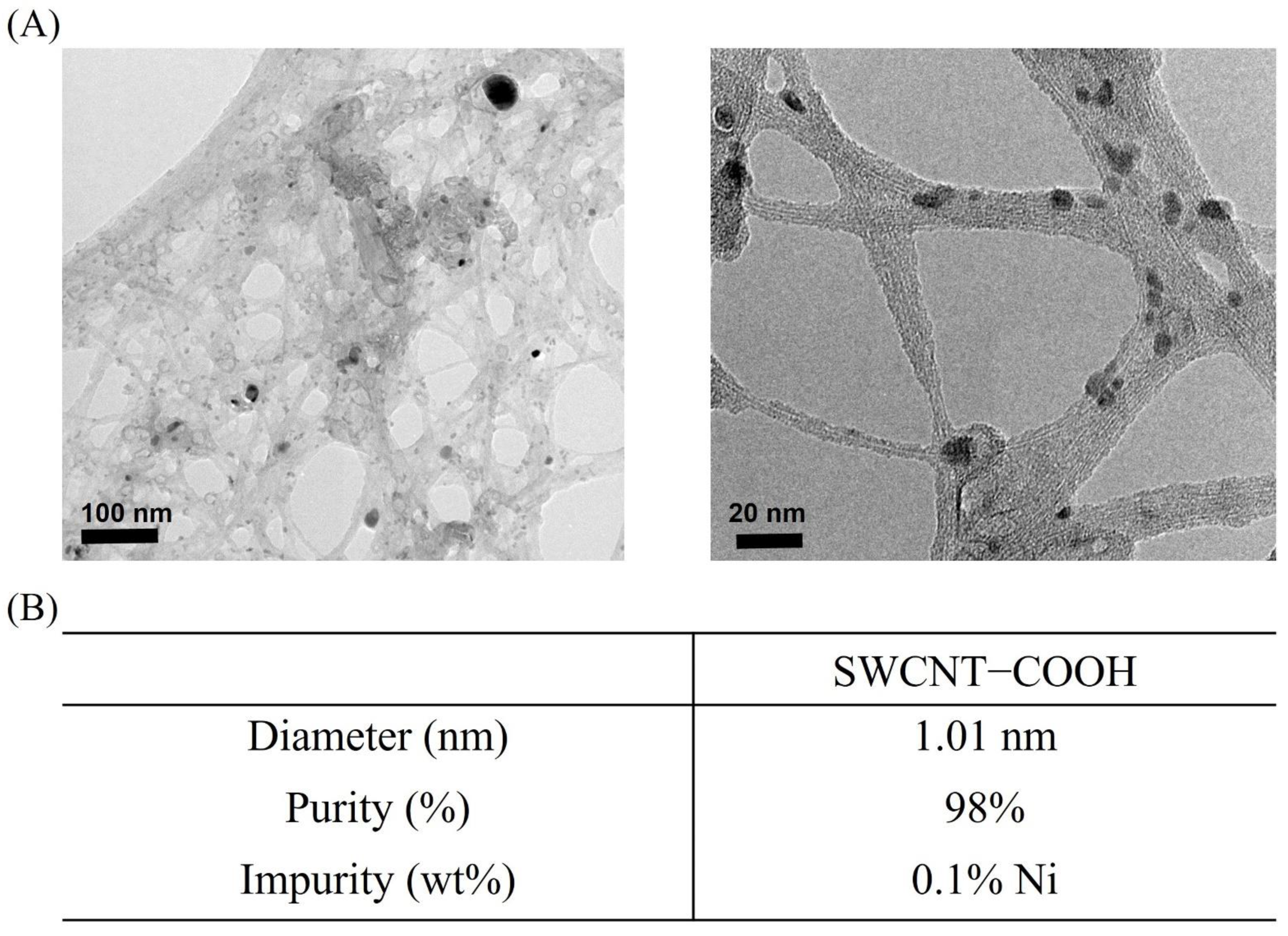


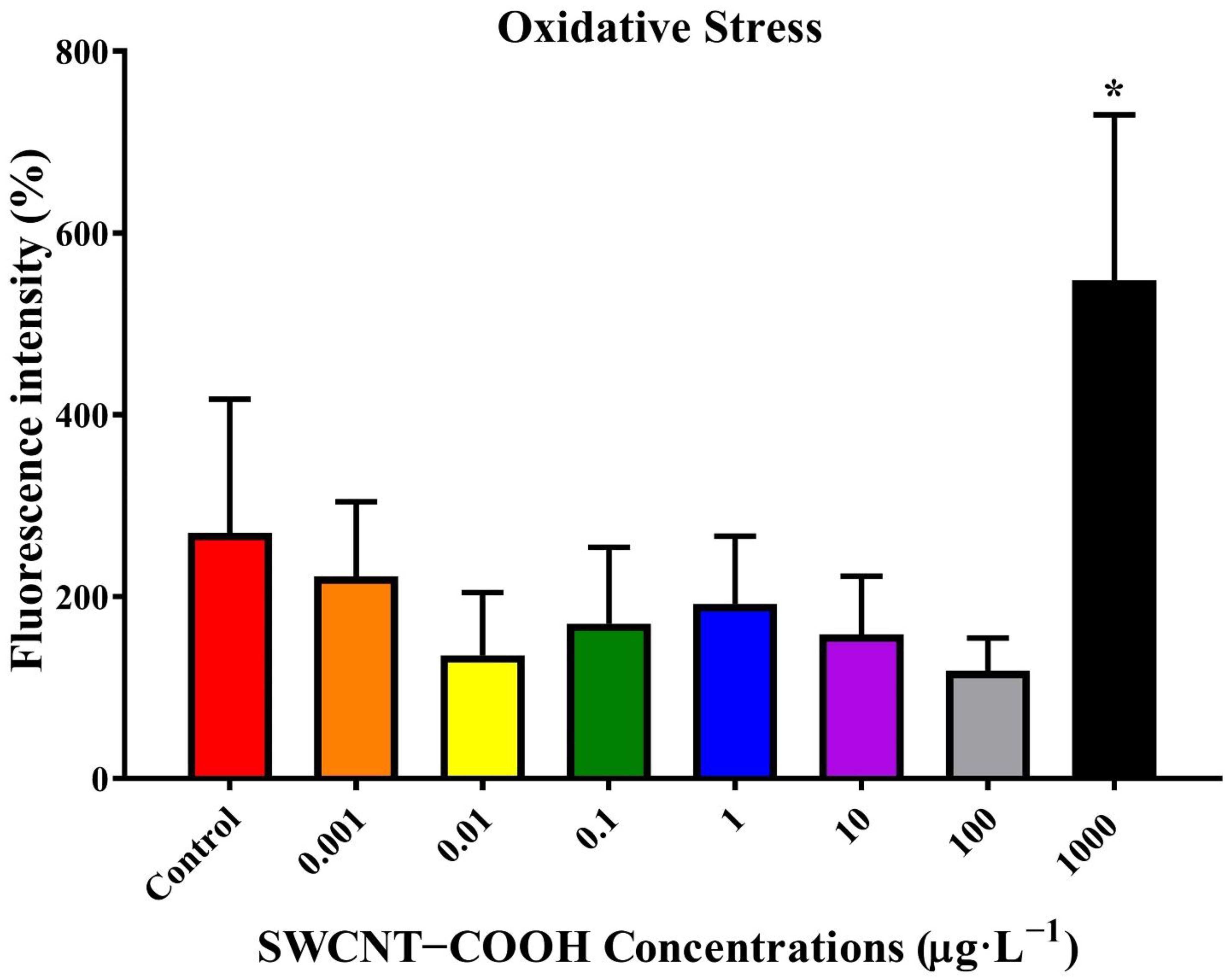
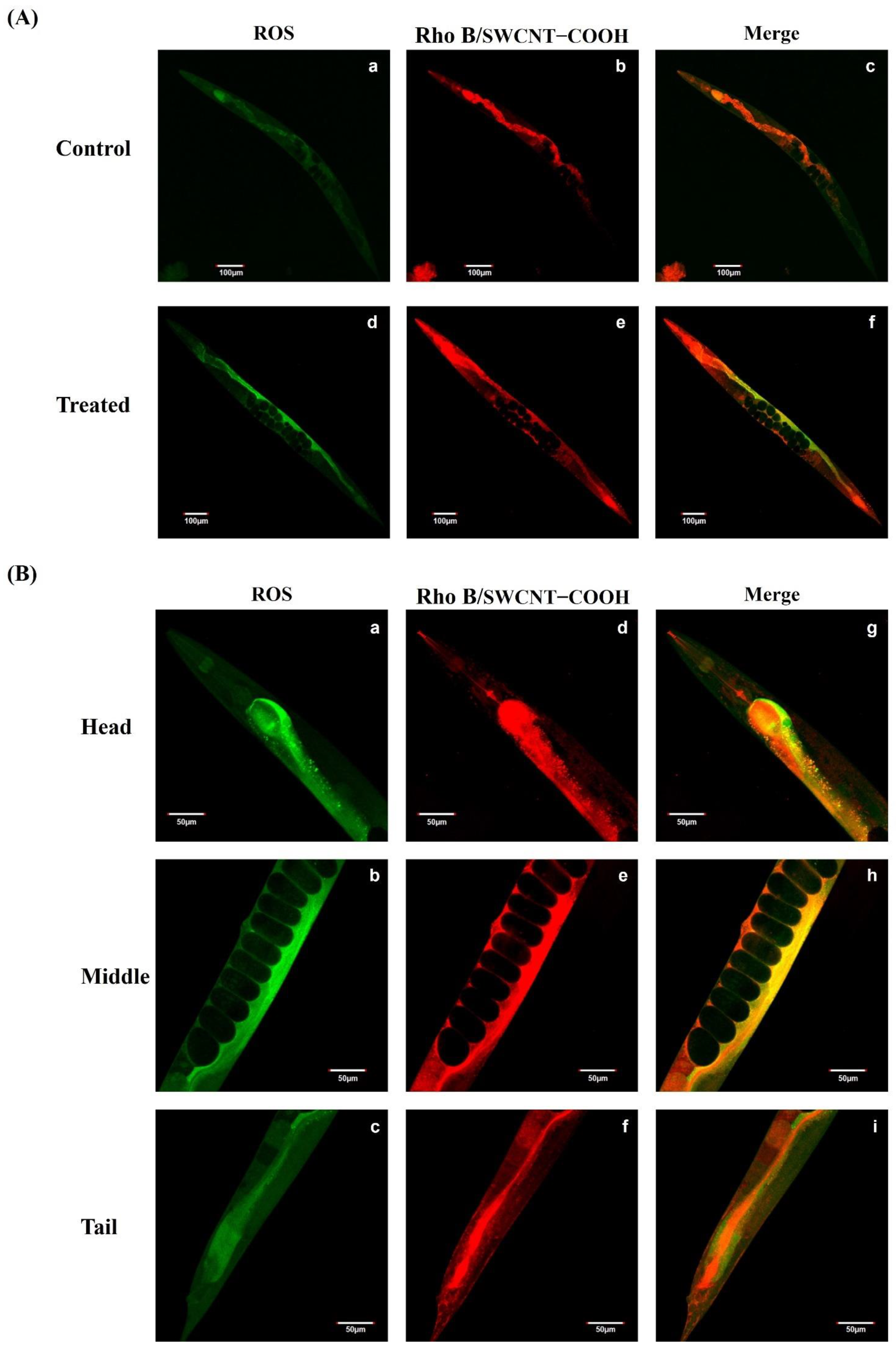
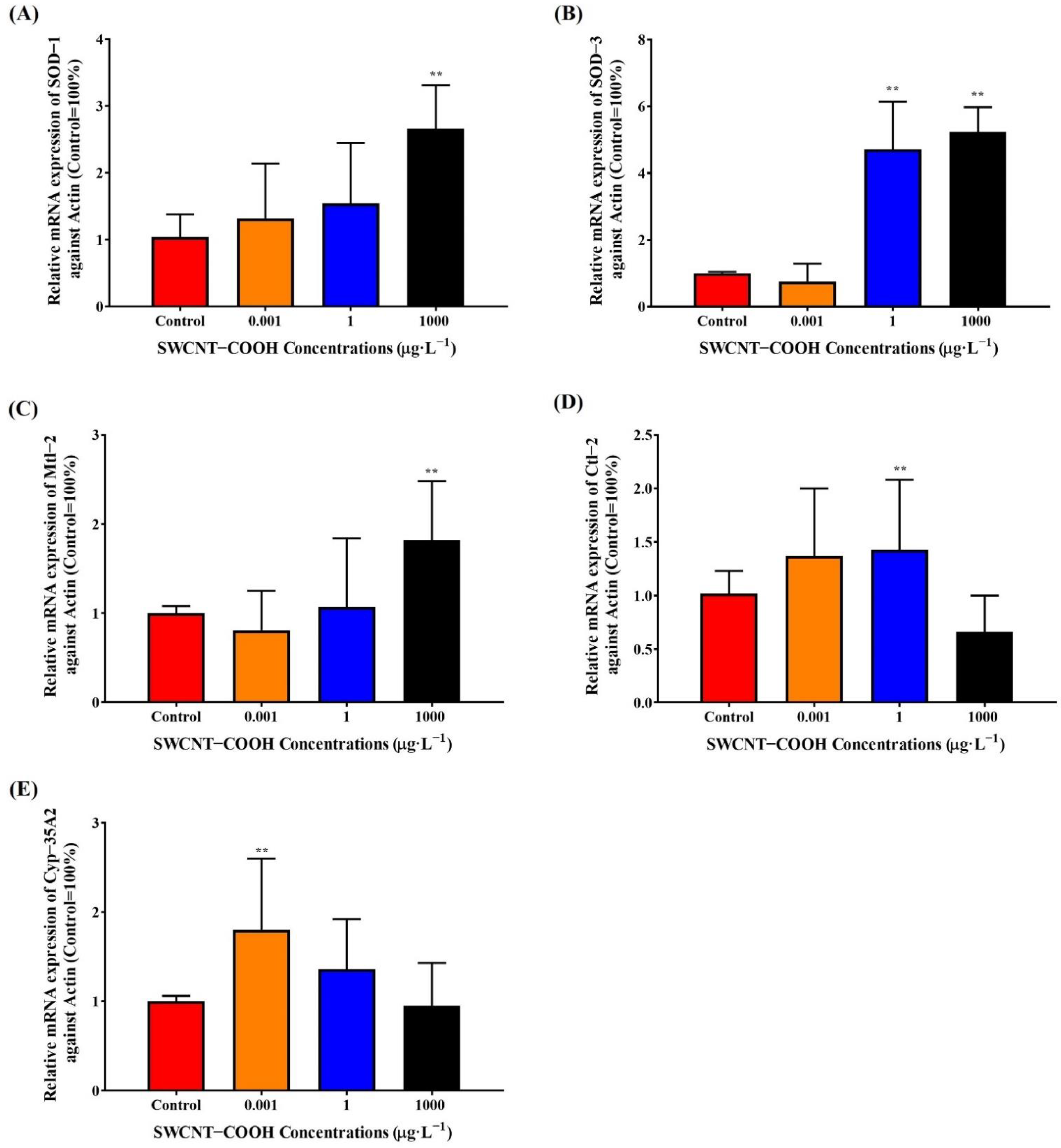
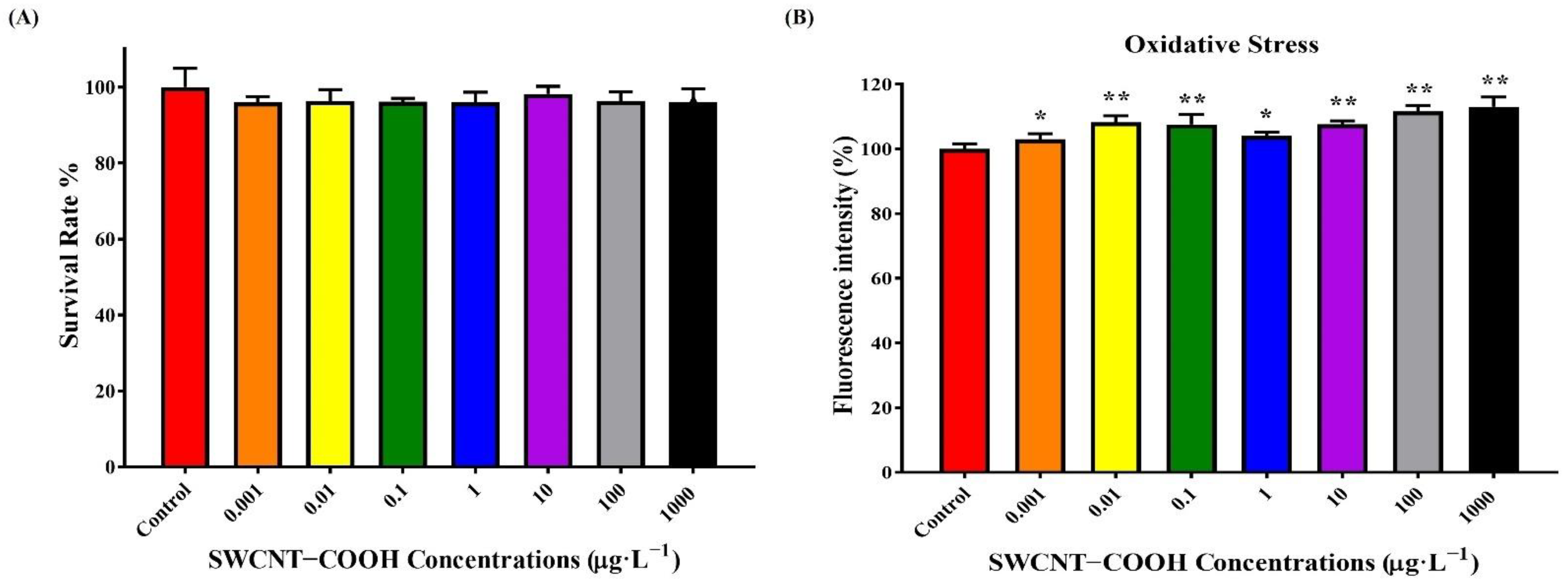

| Gene Code | Forward Primer (5′ to 3′) | Reverse Primer (5′ to 3′) |
|---|---|---|
| C. elegans | ||
| SOD-1 | ACGCTTTACGGTCCAAACAC | ATTCAGAGACGCGATTCAGG |
| SOD-3 | TTGAAGATCGCCACCTGTGCAAAC | ATGGACATAGTCTGGGCGGACATT |
| mtl-2 | AAAAGGCCTACCAGCAGACA | GCAGCAGTATTGCTCACAGC |
| ctl-2 | TCCGTGACCCTATCCACTTC | TGGGATCCGTATCCATTCAT |
| cyp-35A2 | TGCTGGTAAATATGCGGACA | ACACCATTGGTTGCCAATTT |
| Actin-1 | AGAAGAGCACCCAGTCCTCC | GAAGCGTAGAGGGAGAGGAC |
| THP-1 | ||
| Human CAT | CTGGGACTTCTGGAGCCTAC | CAACTGGGATGAGAGGGTAG |
| Human MnSOD | AGAAGTACCAGGAGGVGTTG | AGTGTCCCCGTTCCTTATTG |
| Human CuZnSOD | AGGGCATCATCAATTTCGAG | CCATCTTTGTCAGCAGTCAC |
| Human SOD2 | TGCACTGAAGTTCAATGGTGG | CTTCCAGCAACTCCCCTTTG |
| Human Gpx1 | GAAGTGCGAGGTGAACGGTG | GGGATCAACAGGACCAGCAC |
| Human Gpx2 | AGATGTGGCCTGGAACTTTG | CATTCTGTGAAGGCCCAGAG |
| Human Gpx3 | GAAAGGGGATGTCAATGGAG | ATGAGACGGCCTTCAGTTAC |
| Human Gpx4 | CCAGTGAGGCAAGACCGAAG | CAGCCGTTCTTGTCGATGAG |
| Human GAPDH | TGGACCTGACCTGCCGTCTA | CCCTGTTGCTGTAGCCAAATTC |
Publisher’s Note: MDPI stays neutral with regard to jurisdictional claims in published maps and institutional affiliations. |
© 2022 by the authors. Licensee MDPI, Basel, Switzerland. This article is an open access article distributed under the terms and conditions of the Creative Commons Attribution (CC BY) license (https://creativecommons.org/licenses/by/4.0/).
Share and Cite
Lu, J.-H.; Hou, W.-C.; Tsai, M.-H.; Chang, Y.-T.; Chao, H.-R. The Impact of Background-Level Carboxylated Single-Walled Carbon Nanotubes (SWCNTs−COOH) on Induced Toxicity in Caenorhabditis elegans and Human Cells. Int. J. Environ. Res. Public Health 2022, 19, 1218. https://doi.org/10.3390/ijerph19031218
Lu J-H, Hou W-C, Tsai M-H, Chang Y-T, Chao H-R. The Impact of Background-Level Carboxylated Single-Walled Carbon Nanotubes (SWCNTs−COOH) on Induced Toxicity in Caenorhabditis elegans and Human Cells. International Journal of Environmental Research and Public Health. 2022; 19(3):1218. https://doi.org/10.3390/ijerph19031218
Chicago/Turabian StyleLu, Jian-He, Wen-Che Hou, Ming-Hsien Tsai, Yu-Ting Chang, and How-Ran Chao. 2022. "The Impact of Background-Level Carboxylated Single-Walled Carbon Nanotubes (SWCNTs−COOH) on Induced Toxicity in Caenorhabditis elegans and Human Cells" International Journal of Environmental Research and Public Health 19, no. 3: 1218. https://doi.org/10.3390/ijerph19031218






